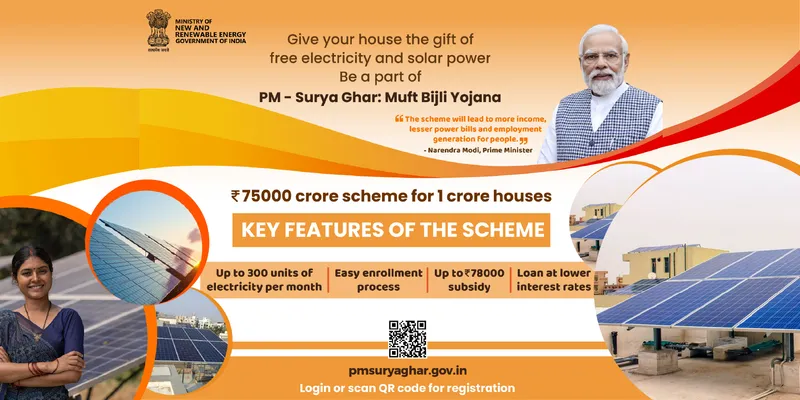Make electricity while the sun shines: India’s solar rooftop ambitions
In February, the government officially rolled out a Rs 75,021 crore rooftop solar scheme PM’s Surya Ghar Muft Bijli Yojana to benefit 1 crore families. Is this the watershed moment for India's population-scale call to climate action?
Anirban Mukherjee

Monday March 18, 2024 , 7 min Read
Amit Mehrauliya, a resident of Jabalpur, had the rooftop of his Narmada Road home fitted with large solar panels recently. The intention was not only to run the appliances in his household cheaply and efficiently but also to feel that he was contributing to something bigger.
“First, it saves your money, and second, the most important benefit, it reduces carbon footprint and promotes green energy,” the young beneficiary said in a testimonial for the PM’s Surya Ghar Muft Bijli Yojana.
By making solar rooftops a reality at the residential level, the PM Surya Ghar Yojana could inspire a population-scale call to climate action.
In February, the government officially rolled out a Rs 75,021 crore rooftop solar scheme to benefit 1 crore families. Households that successfully apply to it will receive 300 units of free electricity. They will also be given a subsidy starting from Rs 30,000 for 1kW systems up to Rs 78,000 for 3kW systems.
Plus, they can access low-interest loans—7% at present, without collateral—for installing products. That could position a household to save Rs 15,000 to Rs 18,000 annually.
Home to 39 of the world's 50 most polluted cities, India has been facing an air quality crisis. The country’s COP26 pledges offer a roadmap: they include a 45% reduction in carbon intensity, a 1 billion-tonne emissions cut by 2030, and reaching net zero by 2070.
The Surya Ghar Yojana isn't just a programme for sustainable living; it could be the linchpin that unites India's climate initiatives. By integrating solar homes with the push for EVs, storage solutions, and public awareness campaigns (LiFE or Lifestyle for Environment), it offers a holistic approach to achieving a clean energy future.

The solar story so far
Solar rooftops are not a brand-new idea. But getting it to scale has been one of the most complicated B2C puzzles, not only in India but across the world. It needs a diverse set of variables to fall into place, including grid capacity, power regulations, and net metering infrastructure. And most importantly, it needs the ability and willingness of millions of households to invest in renewable and sustainable power.
That is no easy puzzle to crack. Let’s dive into some of the biggest roadblocks that have so far slowed down the widespread adoption of solar rooftops.
First, why should a household, which otherwise spends only a few thousand annually for electricity, put aside tens of thousands upfront for renewable power?
Rooftop solarisation worked for large commercial and industrial players with access to capital. But the appeal for the residential sector has been muted, and today more than 90% of solar rooftop installations are in the commercial and industrial segment. Residents hesitate on account of the high cost of solar panels and related infrastructure, even though it pays off significantly in the long term. To install a solar panel system in India in 2024, it is estimated that a household would have to part with about Rs 1.5 lakh to Rs 5 lakh.
Financing considerations have caused doubts too: Who should bear the risk of capex and supply, in a landscape where customers can easily switch electricity providers based on cost? Considering the long payback period for solar investments, very few homeowners felt convinced to make the shift.
Further, how willing and able are our banks to lend without any real collateral to such a mass scale of decentralised borrowers, with varying degrees of creditworthiness?
Finally, on the infrastructure level, the question many have been asking is how prepared is an already overburdened grid to accept input power from residential and commercial users with surplus renewable power.
The new Surya Ghar Yojana is a bold attempt to acknowledge and address each of these questions.

The Surya Ghar Yojana could be the linchpin that unites India's climate initiatives.
Something for every stakeholder
Every stakeholder now has a role to play in completing the solar jigsaw.
Discussed during the Budget announcement this February, the Surya Ghar scheme was approved by the cabinet by the end of that month. The government, by targeting to remove major obstacles to solarisation, has both signalled intent and showed continuity of purpose. It foresees adding 30 GW of solar capacity in the residential sector and reducing 720 million tonnes of CO2 equivalent emissions over 25 years.
The significant subsidy attached could give banks reasons to boost solar lending and suppliers to expand their offerings.
For banks in India, growing their green book is becoming an increasingly important mandate, and it calls for developing deep new structures for blended financing.
Early signs of new rigour in solar financing and distribution are already emerging. In March, for instance, the Union Bank of India and Tata Power Solar Systems renewed a three-year agreement and brought the residential segment into their fold, where they once focused only on the commercial and industrial segments.
Most importantly, the Indian consumer, particularly the lower income demography, will be stimulated to join the green journey on the back of an economic model that assures free electricity. Solar could become a bigger part of the lives and livelihoods of Indians, with about 17 lakh jobs expected to be created in manufacturing, logistics, sales, supply chain, installation, operation and management.
Heart, but also pockets
While at its core the Surya Ghar Yojana appeals to the sustainable self within all of us, there are distinct and material ambitions it can help meet.
- It has the potential to create a 10X increase in residential rooftop capacity, and catapult India to overtake the US and become the second-largest solar PV market in the world.
- Financing the Surya Ghar Yojana could be a Rs 50,000 crore opportunity for India's green lenders.
- As the peak electricity demand in summer shifts from early evening to afternoons, as more and more Indians rely on air conditioners, the decentralised solar solution would be key to flattening the curve and relieving the pressure on the grid.
- Saving of close to 720 million tonnes of CO2 over the 25-year period, even a notional economic value of $10/tonne of CO2 (EU carbon price is closer to $100 per tonne) would indicate a $7.2 billion implicit value generation potential.

Financing the Surya Ghar Yojana could be a Rs 50,000 crore opportunity for India's green lenders.
Social impetus from solarisation
The promise of solar rooftops is as much about savings as it is about upliftment. Guaranteeing affordable and reliable electricity for every household could mean a sizable boost to self-sufficiency and economic confidence among common Indians.
Free electrification of up to 300 units could level the field by stoking the capacity of people in smaller cities to access and use the energy they require to thrive.
For context, households in Delhi, which have the highest electricity consumption among Indian cities, consume about 250-270 units of electricity, based on a 2017 report by the Centre for Policy Research.
With sufficient power, it will be possible for members of a lower-income home to prepare meals for less with energy-efficient cookstoves, have a better quality of life under lights and fans, and enjoy mobility by easily charging their electric 2-wheelers. If they can collect surplus energy, residents could even make money while the sun shines by selling it to discoms.
As it follows, Indians, especially young Indians, are showing enthusiasm for the cause. It is being popularised with simple but innovative initiatives. Just as the corporate sector has adopted and made certified green buildings a proud destination for their latest new branch, it's time the common citizen takes pride in owning a certified Green Home, complete with a solar rooftop. Maybe, a selfie with the brand-new panels at the next Griha Pravesh?







![[Exclusive] Vauld to seek 3-month moratorium extension as creditors panel explores bailout options](https://images.yourstory.com/cs/2/a09f22505c6411ea9c48a10bad99c62f/VauldStoryCover-01-1667408888809.jpg)

